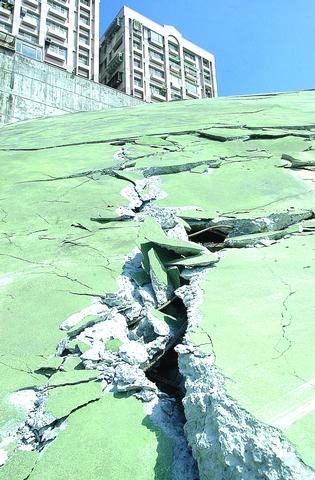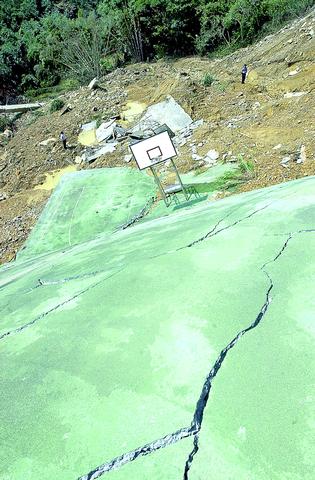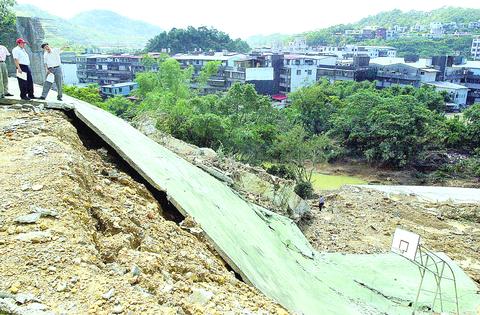Seeing that the retaining wall near her building had "finally" collapsed into the river it was intended to block, Kao Shu-ling (
Kao and her husband, Chou Chih-chuan (周志全), are residents of the infamous Lincoln Mansions (林肯大郡) in Hsichih, Taipei County. Four years ago Typhoon Winnie caused a mudslide that came crashing down onto the housing complex, collapsing one five-story building and killing 29. The incident sounded a first warning about the safety of hillside residences.

PHOTO: CHEN CHENG-CHANG, TAIPEI TIMES
The residents of Lincoln Mansions, especially Kao and Chou, made their names known to the public through their constant protests over the imminent danger in which the remaining buildings in the complex were standing and made repeated demands for compensation and reconstruction, largely to no avail.

PHOTO: CHEN CHENG-CHANG, TAIPEI TIMES
Ongoing struggle
For better or for worse, Typhoon Nari did not forget the Lincoln Mansions. During the night of the typhoon, pouring rain and surging flood waters washed away the retaining wall into the Peikang River

PHOTO: CHEN CHENG-CHANG, TAIPEI TIMES
After the retaining wall's collapse, residents were immediately evacuated to Peikang Elementary School, where they slept on the gym floor. Coverage of the wreckage at Lincoln Mansions was scant, given the scale of the disaster in other areas, but for the complex's 700 residents, the wreckage of their community is an exciting piece of news. If somewhat ironically, Nari finally proved that their houses were structurally unsound.
"I just could not help feeling that the gods must have sympathized with our effort through the years," Kao said. "Last week, I was still wearing out my voice, doing a presentation for government officials, explaining the dangers of our house." On Monday, when Kao's neighbor phoned her about the collapse, she thought it was a joke.
"Now I have a triple identity -- Typhoon Winnie victim, 921 Earthquake victim (the quake left several cracks to the building), and now Typhoon Nari victim. Let's see if this new identity is of any use," Kao said jokingly.
Four years ago when typhoon Winnie hit Lincoln Mansions and left 29 dead, the remaining residents of the community came to realize the hazard of their housing complex. The fourth building in the complex, where Kao and Chou live, was later found to have been illegally built on a 62o slope by the river. The buildings were also discovered to have been illegally built on the same structure as the retaining wall. An investigation later uncovered a falsified geological prospecting report.
Joining hands
for naught
"When all those illegal matters came out in 1997, we realized there was no way we could live in the house. So we decided to organize to demand for compensation," said Kao.
The Lincoln Mansions' Resident Self-help Association held over 200 negotiations with Taipei County officials, Ministry of Interior officials, as well as all sorts of building and structure experts. The Taipei County Government's decision was to reinforce the compound's structure and design a better drainage system on the hillside, rather than build new houses for the residents in a new location, as they had demanded. The action for compensation then became a long-term argument over whether the entire complex was safe or not.
"Officials told us that the safety issues are perhaps more psychological, and recently the negotiation meetings had become more like mental counseling. The struggle had stalled in a stalemate," said Kao.
Until Monday's Nari flooding, the residents of Lincoln Mansions lived in constant, mortal fear of typhoons.
The buildings made it through several major typhoons after Winnie and even the 921 Earthquake. But Typhoon Nari seems to have marked the last chapter in the community's long saga. The county government has ordered the area evacuated until further notice. In the meantime, residents will have to find temporary housing on their own.
Taipei County Government officials and the minister of interior on Thursday sent experts to re-assess the situation at Lincoln Mansions. No decision on whether to abandon the site or reinforce it is expected any time soon. Kao just hopes it won't take another four years.

One of the biggest sore spots in Taiwan’s historical friendship with the US came in 1979 when US president Jimmy Carter broke off formal diplomatic relations with Taiwan’s Republic of China (ROC) government so that the US could establish relations with the People’s Republic of China (PRC). Taiwan’s derecognition came purely at China’s insistence, and the US took the deal. Retired American diplomat John Tkacik, who for almost decade surrounding that schism, from 1974 to 1982, worked in embassies in Taipei and Beijing and at the Taiwan Desk in Washington DC, recently argued in the Taipei Times that “President Carter’s derecognition

This year will go down in the history books. Taiwan faces enormous turmoil and uncertainty in the coming months. Which political parties are in a good position to handle big changes? All of the main parties are beset with challenges. Taking stock, this column examined the Taiwan People’s Party (TPP) (“Huang Kuo-chang’s choking the life out of the TPP,” May 28, page 12), the Democratic Progressive Party (DPP) (“Challenges amid choppy waters for the DPP,” June 14, page 12) and the Chinese Nationalist Party (KMT) (“KMT struggles to seize opportunities as ‘interesting times’ loom,” June 20, page 11). Times like these can

Dr. Y. Tony Yang, Associate Dean of Health Policy and Population Science at George Washington University, argued last week in a piece for the Taipei Times about former president Ma Ying-jeou (馬英九) leading a student delegation to the People’s Republic of China (PRC) that, “The real question is not whether Ma’s visit helps or hurts Taiwan — it is why Taiwan lacks a sophisticated, multi-track approach to one of the most complex geopolitical relationships in the world” (“Ma’s Visit, DPP’s Blind Spot,” June 18, page 8). Yang contends that the Democratic Progressive Party (DPP) has a blind spot: “By treating any

You can tell a lot about a generation from the contents of their cool box: nowadays the barbecue ice bucket is likely to be filled with hard seltzers, non-alcoholic beers and fluorescent BuzzBallz — a particular favorite among Gen Z. Two decades ago, it was WKD, Bacardi Breezers and the odd Smirnoff Ice bobbing in a puddle of melted ice. And while nostalgia may have brought back some alcopops, the new wave of ready-to-drink (RTD) options look and taste noticeably different. It is not just the drinks that have changed, but drinking habits too, driven in part by more health-conscious consumers and